Digital Marketing Drives Golf Course Growth: What Data Says About Improving Your Online Presence
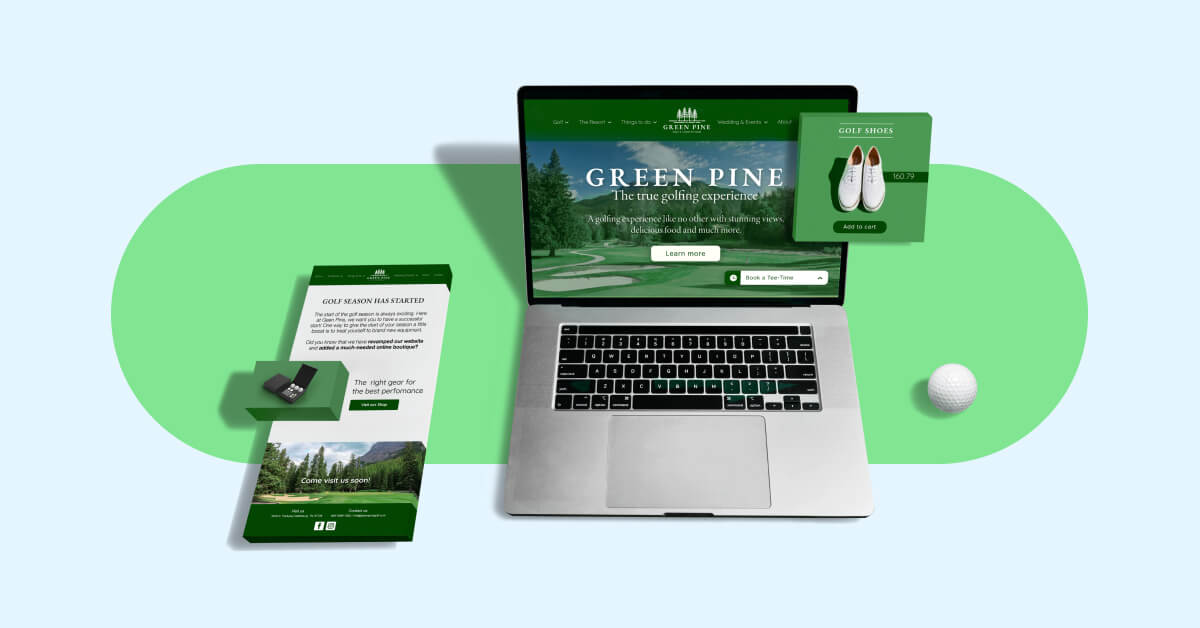
With golfers increasingly turning to digital channels to discover golf courses, engage with brands and seek out great booking experiences, is your golf facility committing enough time and resources to building a strong online presence via golf digital marketing?
We consulted survey data1 and year-over-year (YOY) data2 from over a hundred different courses across North America that use Lightspeed’s Digital Marketing Solutions to illustrate how a strong online presence and digital marketing strategy is essential to stay competitive in golf’s new digital landscape
Dive into the data below and to gain valuable insights into why your online presence is so important and the key channels you need to invest in.
Access the complete guide
Download our free guide to discover detailed data and insights on how a strong digital marketing strategy can drive real growth for golf courses.
Our findings
We looked at year-over-year (YOY) data from over a hundred different courses across North America that use Lightspeed’s Digital Marketing Solutions. The data indicates that the longer courses are live with Lightspeed, the more success they have in driving online engagement, sales and bookings.
After their initial three months, courses that were live with our digital team between 90 and 180 days saw a 64.6% increase in Facebook reach and a 142% increase in website sessions.
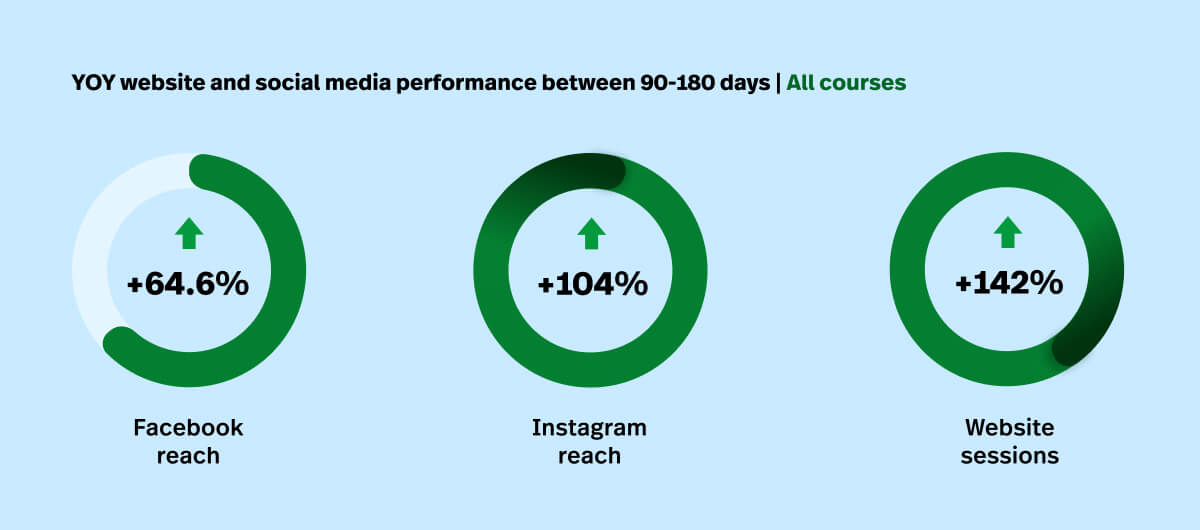
More awareness and engagement drove sales and bookings
This significant improvement in top-of-the-funnel golf digital marketing activity anticipated an increase in sales and bookings at the bottom of the funnel.
Golf courses that were live between 90 and 180 days saw a 4.3% increase in total sales and a 2.7% increase in rounds.
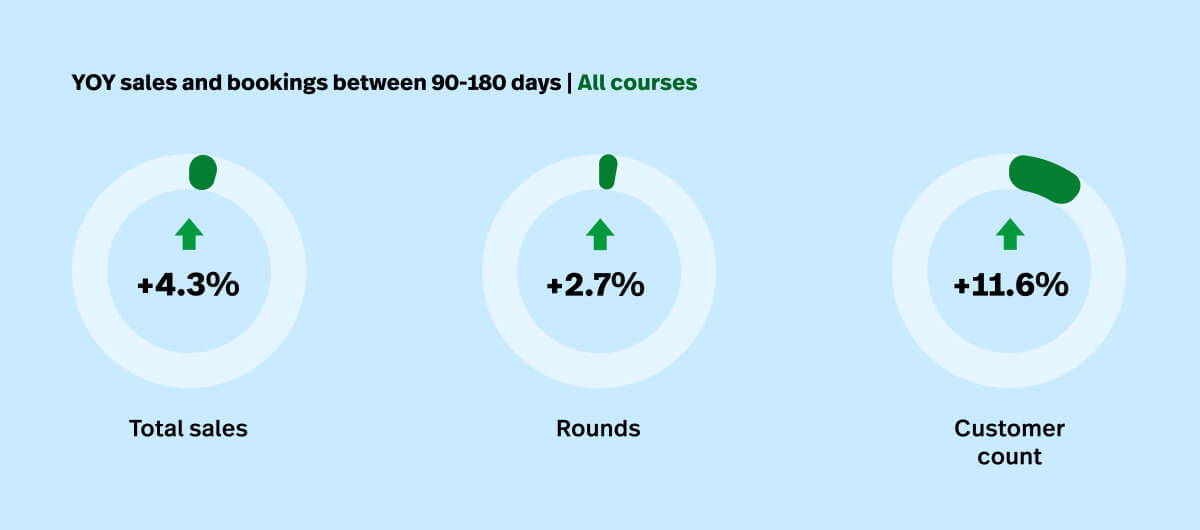
These performance indicators increased the longer golf courses continued to have their digital marketing managed by Lightspeed’s team.
Courses that were live between 90 and 270 days saw total sales increase by 5.9% and rounds increase by 4%.
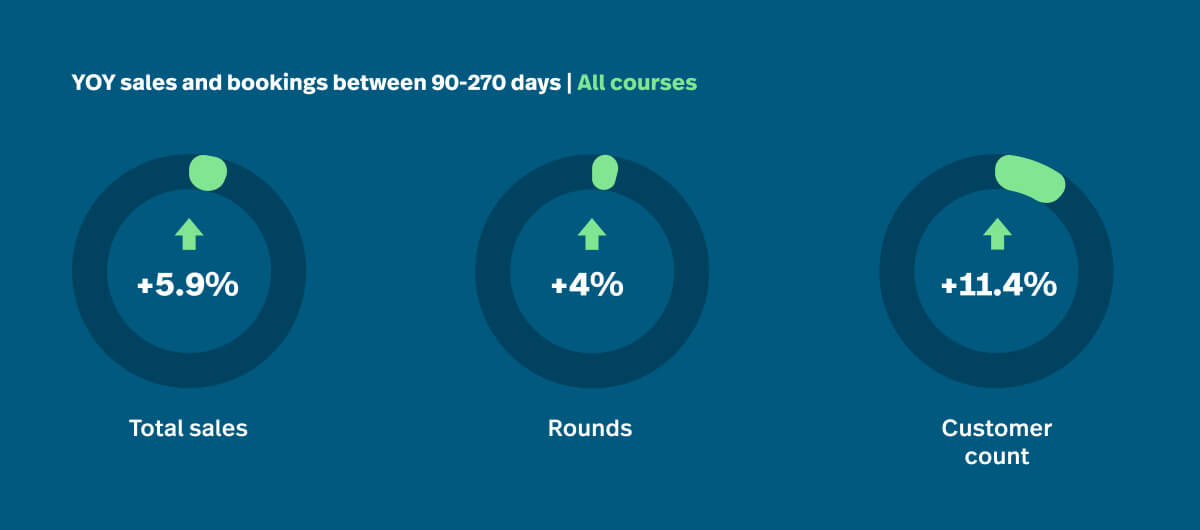
Golf digital marketing and seasonality
Because the game of golf is a seasonal business, it’s important to break down golf course marketing performance during crucial operational months.
Let’s consider courses situated in the northern parts of the USA and Canada who went live with Lightspeed’s Digital Marketing Solutions during their off-season: October, November and December.
Starting off right
With their season underway, northern courses that were live between 90 and 180 days saw a 155.7% increase in Facebook reach and a 505.9% increase in web sessions.
In that same period, northern courses saw a 11.9% increase in total sales, and a 13.9% increase in customers.
Performance stayed strong as their digital marketing programs matured
Northern courses that were live between 90 and 270 days saw a 24% increase in total sales, a 21.7% increase in customers and a 30.5% increase in rounds over the previous year’s data.
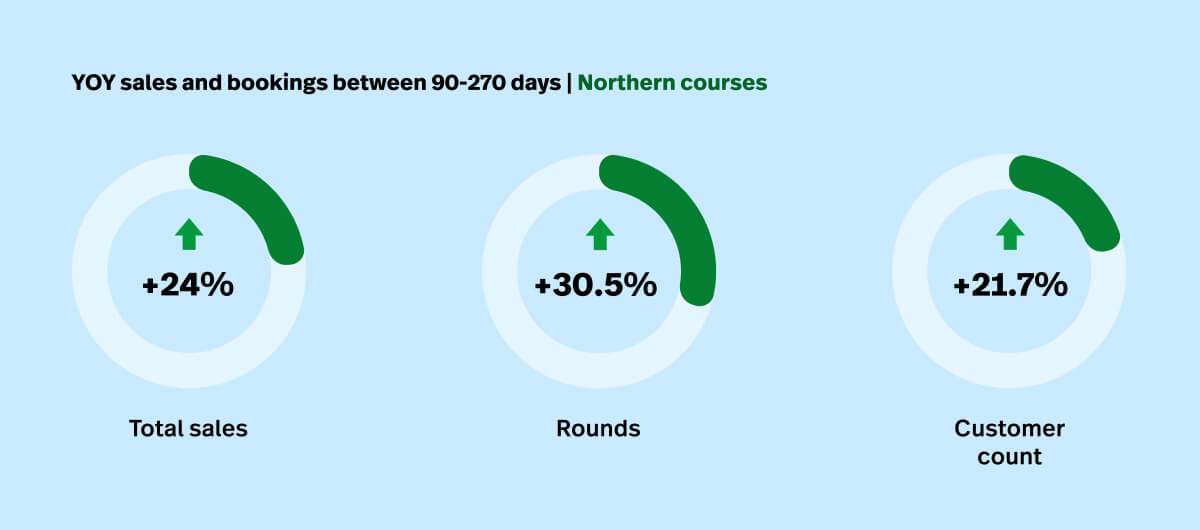
Finishing strong
This growth trend continued with northern courses who were live between 90 and 365 days, with rounds, sales, green fees and customers all up year-over-year.
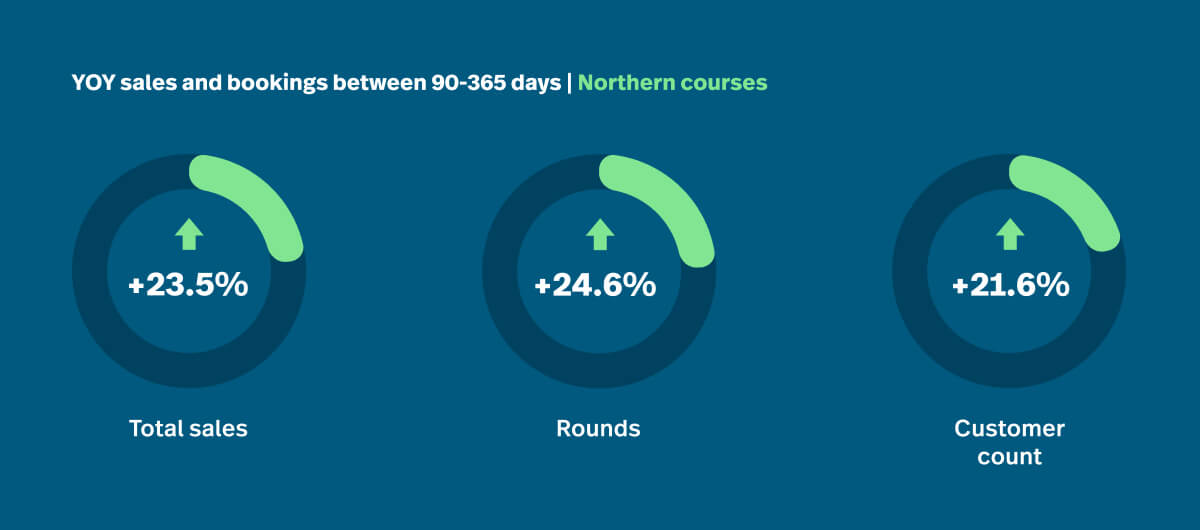
Why the time is now to embrace golf course digital marketing
Responding to golf’s changing demographics
Recreational golf has experienced unprecedented momentum over the past few years. Participation is up in key demographics and has been since the pandemic drove more people to try the game. This is especially true among 18-34 year olds, who make up the game’s largest customer age segment.
Golfers in this 18-34 age range have largely grown up with the internet and leverage digital marketing daily to discover brands, inform purchasing decisions, and book and pay for goods and services.
These golfers also represent your customer base of the future. Resonating with these valuable customers through timely, tailored digital marketing efforts is key to:
- Generate awareness
- Build their trust
- Win their business
- Become their favorite option over other courses in the area
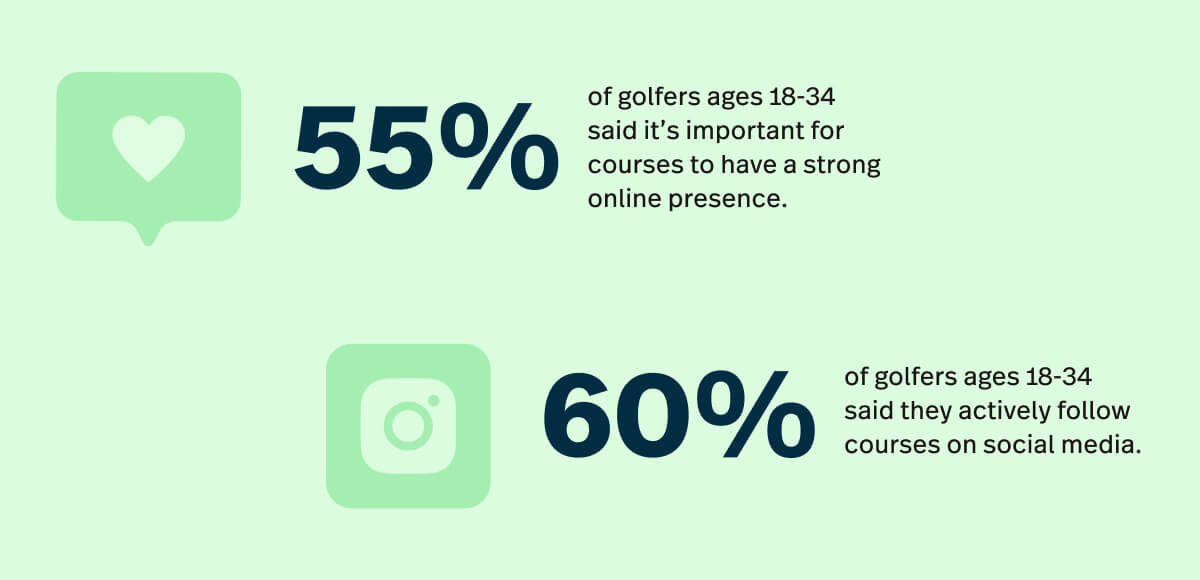
Online visibility helps create more avenues towards bookings
The dynamics of how golfers book tee times has changed. Online booking is certainly not a new concept, but it’s worth considering the numbers.
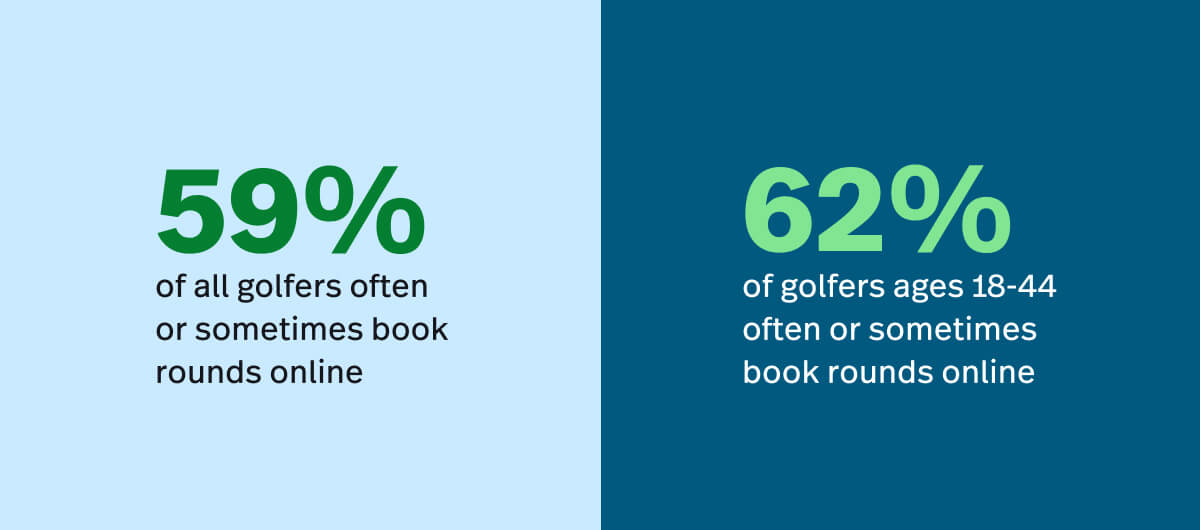
With a majority of golfers leveraging this approach, having a user-friendly online booking system is critical for revenue-focused golf facilities.
But offering online booking is only one part of the equation. Another challenge is driving golfers to your booking page as often as possible, via as many avenues as you can.
This is where a golf course digital marketing strategy comes in: it helps you drive web traffic to your website’s booking page from emails, Instagram posts, online ads, Google search results, third-party websites and other critical channels.
Ultimately, creating this larger online presence through a sound digital marketing strategy means creating more ways for golfers to find and book rounds.
Measurable results lead to more efficient efforts
Not every golf digital marketing tactic is going to be a success. A major advantage of marketing via digital platforms like Lightspeed Golf, Facebook, Instagram and Google is how much easier it is for golf course operators to access metrics on what worked, what didn’t and why. Data-fueled digital marketing can help you:
- Create focused marketing strategies
- Track goals against clear performance metrics
- Evaluate the ROI of your activities and campaigns
- Make data-driven adjustments and optimizations for the future
The performance data available in digital marketing platforms and golf management software can help you stay focused on the tactics that matter most to your course. With you and your team already investing so much time and energy into daily tasks, finding ways to operate with more efficiency and decisiveness can make a major difference.
Diving deeper: Key golf digital marketing tactics and channels for courses
The landscape of golf digital marketing is full of new avenues to invest in. This makes it easy to lose sight of the must-have marketing tactics and channels for golf facilities looking to scale and drive more revenue. Let’s cover these now.
Website optimization
Your golf course’s website is the foundation of all your efforts online, and nearly all your digital marketing tactics will drive users there.
Assessing and improving your website can feel daunting, but it’s a critical step toward creating a stronger online presence. Remember that 75% of golfers we surveyed said it was important for golf courses to offer a good website experience.1
There’s a lot that goes into creating an amazing website, but here are some of the essentials:
- Create a user-friendly website that’s optimized for desktop and mobile
- Follow Google’s SEO Search Essentials to aid in stronger search engine rankings
- Give your homepage a strong visual identity and firmly establish your brand
- Invest in high-quality photos, videos and other media to draw user interest
- Let your online booking widget stand out and stay visible above the fold
- Organize all course information into a well-structured navigation menu
- Use bold, compelling copy, but be clear and concise with key information
- Use strong call-to-action (CTA) buttons to guide users to key pages
- Update your homepage regularly with news, events, promos, etc.
- Include a header bar with contact details and links to social media pages
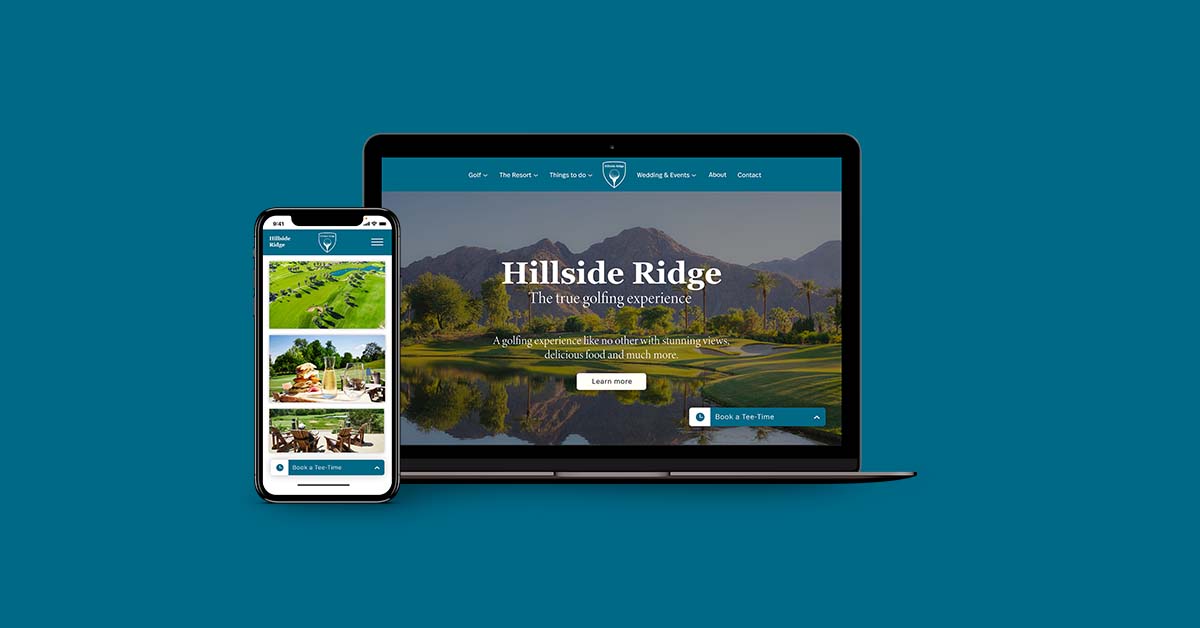
Email marketing
Email marketing remains a highly effective way to engage with customers. However, blasting poorly designed emails at random to your entire database simply won’t work. The key is to leverage strategy and automation to send the right golf course emails, to the right people at the right time.
Over half (53.5%) of golfers ages 18-54 like to receive emails from golf courses regarding news promos and events at least weekly1
Segment your list and send emails with a purpose
Golfers’ email addresses arrive in your database from a wide range of sources: newsletter subscribers, booking confirmations, membership sign-ups and inquiries, pro shop purchases and more. With the right software, you can properly segment and organize these contacts into categories such as (but not limited to):
- Player type (public players, private members, age category)
- The last time the recipient played at your course
- How often someone played at your course in a set period
- Those who have inquired about membership or a season pass
- Golfers who have booked but canceled
- Those who have purchased items from the pro shop
- Newsletter recipients only
- Members, season pass holders
You can then send highly targeted emails that resonate with these groups—from specials and promos to newsletters, special event sign-ups and more. It’s even possible to fully automate the email process based on customer activity so you never miss an opportunity.
With a sound segmentation strategy in place, you can increase open rates, decrease unsubscribes and stay relevant to customers at different stages of the marketing funnel.
Craft your emails with a purpose
No matter the email, you are likely to see better engagement and conversions if you use beautiful, branded templates, engaging copy and clear call-to-actions.
It’s important to be intentional when designing your email templates and drafting copy. Whereas newsletters can contain multiple modules for words and images, promotional emails should be short on copy, visually striking and immediately draw the recipient to the promo details.
Learn from your email data
Open rates, bounce rates, click-through-rates—these key data points help you understand which emails are working and which ones miss the mark. This data is readily and easily available via email marketing software, so make a habit of reviewing your email data with your team and plot out any necessary adjustments.

Social media marketing
Social media channels like Instagram and Facebook have become indispensable tools for raising awareness and engaging with golfers. According to our survey data, this is especially true among 18-44 year olds:
| Percentage of survey respondents who follow golf courses on social media by age1 | ||
| 18-24 | 25-34 | 35-44 |
| 69.6% | 57.1% | 64.8% |
Primary reason for following golf courses on social media (18-44 year olds)1
- Local golf course booking
- Local golf course event information
- Aspirational interest to travel to a golf destination
- Championship interest about the host / event
- Interest in the challenge the specific course offers
- Golf training purposes
What’s striking is that the most active followers of golf course social accounts do so to access information about courses in their area. This is why it is so essential for golf courses to actively post on their social accounts:
- Establish a posting cadence and stick to it
- Review your profiles regularly to ensure images and info are up to date
- Curate your posts wisely and prioritize quality over quantity
- Mix it up! Don’t post the same content repeatedly
- Run contests requiring users to like, share and comment in order to enter or win
- Update followers on key course info as it changes
- Engage with followers, re-share content and show off your brand personality
It might seem daunting, but the more you actively engage with social media as a viable marketing tool, the more success you’re likely to see.
Pay-per-click (PPC) ad campaigns
Pay-per-click (PPC) advertising is a model where advertisers pay a fee each time their ad is clicked. Instead of paying for a physical ad placement on a billboard or bus stop, you only pay when users engage with your ad, making it far easier to budget and measure ROI.
With PPC, advertisers bid on relevant keywords and audience segments, and platforms like Google and Meta (Facebook and Instagram) display ads to users based on bid and ad relevance.
- Google: Advertisers bid on relevant search keywords; ads appear as search results
- Facebook and Instagram: Bids are for audiences and interest groups; ads appear as static images or videos in users’ social feeds
What keywords or audiences will you bid on? What ad formats will you try? Are you after awareness or bookings? Who will design your ads and write copy? PPC involves a lot of testing, trial and error, but it’s a highly effective way to reach golfers both locally and from afar.
Google Business Profile
The Google Business Profile listing is a free tool that allows golf courses to manage their online presence across Google Search and Maps. It includes the following:
- Business Name: The official name of your golf course
- Address: The physical location of the course, with a link to Google Maps
- Phone Number: A direct contact number for inquiries and bookings
- Website: A link to your course’s official website
- Hours of Operation: The days and hours your course is open for play
- Business Category: Golf Course, Driving Range, etc.
- Photos and Videos: Visuals showing your layout, clubhouse, amenities, etc.
- Reviews and Ratings: Customer reviews, along with the overall rating out of five stars
- Posts: Updates about events, promotions, or news
- Services: Information on offerings such as tee times, lessons and tournaments
- FAQs: A section allowing users to see common questions and inquiries
Your Google Business Profile listing is useful regardless of whether users are searching for “local golf courses” or for your specific golf facility. A well-optimized listing with accurate course details, photos, reviews and hours can help you boost visibility, build trust and make it easier for golfers to book tee times.

Managing online reviews
Managing online reviews is a crucial part of maintaining a strong Google Business Profile listing. Take a proactive approach to your online reputation by:
- Monitoring regularly: Track new reviews consistently across all relevant platforms
- Responding promptly: Respond to positive and negative reviews promptly to show you care
- Staying professional: Keep responses polite, especially when addressing criticism
- Encouraging reviews: Invite satisfied golfers to leave reviews to help boost your credibility
- Learning from feedback: Use feedback to identify key areas for improvement
Finally, do not offer incentives for your Google Reviews, as this could hurt your profile’s integrity.
So what’s your next step?
Having your digital marketing efforts and online presence managed by Lightspeed’s Digital Marketing Solutions team of golf marketing experts can help you save time, stay focused on the customer experience and scale your marketing effectively.
If you’re interested in learning more about Lightspeed’s Digital Marketing Solutions team and how it can help you dial in your digital marketing efforts, talk to one of our experts today.
1. Lightspeed Survey Data: This information is derived from the results of a June 2024 Lightspeed-conducted survey of more than 300 North Americans, using third party survey vendor User Testing.
2. Lightspeed Digital Services Course Data: This data compares the year-over-year total sales, occupancy, social media reach and website engagement of North American golf courses fully operational with Lightspeed’s Digital Marketing Solutions service for the period of July 1, 2022 to September 11, 2024. Data accuracy is subject to user entry.</sup
Editor’s note: Nothing in this blog should be construed as advice of any kind. Any legal or financial-related content is provided for informational purposes only. While we work hard to publish accurate content, we cannot be held responsible for any actions or omissions based on that content. Lightspeed does not undertake to complete further verifications or keep this blog post updated over time.

News you care about. Tips you can use.
Everything your business needs to grow, delivered straight to your inbox.


